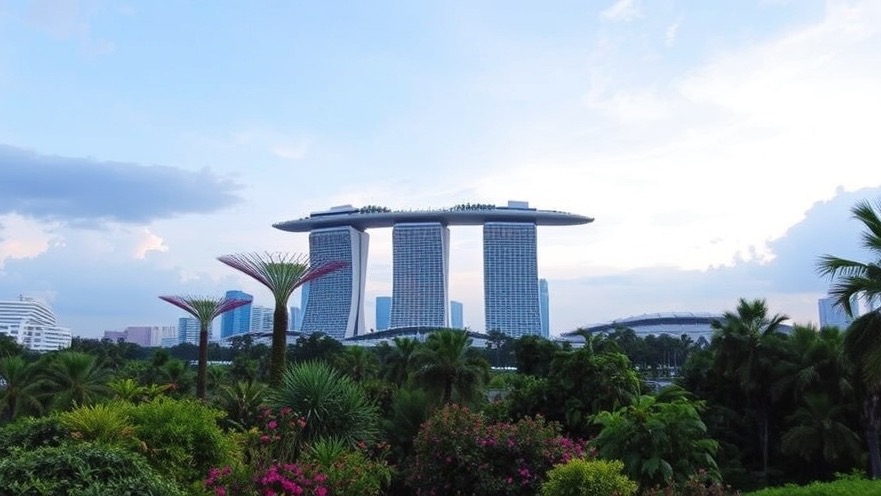
Step back in time at the 11th edition of Tulipmania to explore the tulip's origins and its stories, from epic battles to rediscovered ancient civilisations.
SINGAPORE – Echoes of an epic battle and an ancient civilisation take centrestage at the 11th edition of Tulipmania (梦幻郁金香) at Gardens by the Bay. Amidst a vibrant sea of 65,000 tulips stand wonders of history, such as a recreation of the legendary Trojan Horse from the Battle of Troy and Göbekli Tepe—the world’s oldest known temple and one of the most significant archaeological discoveries of the late 20th century.
Both tulips and these historical icons have roots that can be traced back to the rich landscape of Türkiye. Presented in collaboration with the Embassy of Türkiye to Singapore, Tulipmania was officially launched today by Minister for Education Mr Chan Chun Sing. It will be on until May 12.
Gardens by the Bay CEO Mr Felix Loh said, “Gardens by the Bay offers a horticultural window to the world, and Tulipmania, our longest-running floral display, exemplifies this wonderfully. After all, the tulip’s appeal comes not just from its beauty, but also the different histories, cultures and time periods that it has lasted through. This year, we bring to visitors some truly fascinating icons of history which have roots in Türkiye – just like the tulip, whose origins can be traced to the steppes of Eastern Türkiye and Central Asia.”
Since 2013, Gardens by the Bay has showcased the tulip in myriad ways, from recreating the picturesque tulip fields of the Netherlands, to artistic interpretations of Van Gogh’s masterpieces using tulips, to showcasing its wild origins in Kazakhstan. Each edition of Tulipmania has offered visitors a new lens through which they can appreciate the flower.
Over 30 varieties of tulips of diverse colours and forms
The tulips on show in this year’s Tulipmania come in unusual forms and colour combinations. Some highlights include:
• Tulipa ‘Ballerina’, an elegant, lily-flowered variety with bright orange petals that flare outwards at the tips
• Tulipa ‘Pretty Woman’, which has bright red, goblet-shaped flowers with pointed petals
• Tulipa ‘White Liberstar’, a crown tulip whose elegant white petals gracefully curve outward, characterised by distinctive crown-shaped blooms that were originally the result of a genetic mutation
Tulips were first discovered along mountainous regions of Central Asia, and later rose to prominence during the Ottoman Empire, where they evolved into a symbol of affluence. Varieties that can be traced back to Türkiye often stand out with their distinctive pointed petals and vibrant, contrasting colours. This year’s Tulipmania showcases three such varieties:
• Tulipa acuminata, notable for its striking, narrow petals that mix yellow and red, evoking the appearance of flickering flames
• Tulipa ‘Go Go Red’, arresting for its slim, pointy petals in a striking red that emerge from a bright yellow centre
• Tulipa ‘Fly Away’, which has goblet-shaped flowers of pointed petals that are red but tinged with a yellow margin
The tulip palette is complemented by a variety of colourful blooms native to Türkiye, including hyacinths, fritillaria, hollyhocks and alliums, alongside chamomiles and dianthus.
Timeless treasures of history
Beyond the blooms, Tulipmania also pays tribute to Türkiye’s rich legacy. Visitors can take a journey through different points of its history through recreations of icons such as:
• Trojan Horse: Standing nearly 6m-tall, the recreation of the famed Trojan Horse tells the story of the clever ruse that led to the fall of the ancient city of Troy, which lies in modern-day Türkiye. According to legend, Greek soldiers hid inside the wooden horse to infiltrate the city, marking a pivotal moment that turned the tides in the Battle of Troy in their favour. A battleship that carried more soldiers to Troy complements the Trojan Horse.
• Göbekli Tepe: Recognised as the world's earliest known temple, this UNESCO World Heritage Site dates to around 9,600 BC, predating Stonehenge by some 6,000 years. It caused a global sensation when it was unearthed in the late 20th century and is considered one of the greatest archaeological discoveries of that period. The site features over 200 massive stone pillars arranged in both circular and rectangular formations, crafted by prehistoric people without the use of metal tools or pottery. The lack of residential remains suggests that Göbekli Tepe was a sacred site, dedicated to ceremonial worship.
• Mardin Houses: These well-preserved houses on the mountainside in Mardin, known for their beige limestone construction, are one of Türkiye's most breathtaking destinations. Despite their medieval origins – they date back to 8,000 BC – the architecture of these beige limestone homes is ingenious, as no house blocks the view of another. Built to withstand the challenging climate, the homes feature walls up to 4m-wide with almost no windows.
• Pool of Abraham: Believed to be the site where Abraham, a patriarch revered in Judaism, Christianity, and Islam, was miraculously saved from death by divine intervention. Abraham was thrown into a fire pit by King Nimrod for rejecting his gods, but the flames turned into water. The pool is now celebrated for its sacred fish, which are considered a symbol of this miracle. It is a site of pilgrimage visited by thousands every year.
Mosaic art by students and public workshops
Paying tribute to the wild origins of the tulip, a group of 24 students from Chua Chu Kang Secondary School’s art club tried their hand at the traditional Turkish art of mosaic making. The intricate process involved the students cutting up glass into smaller fragments and carefully piecing them together to form designs of Ottoman tulips and other floral motifs. The three beautiful mosaic artworks will be on display throughout the duration of Tulipmania for all visitors to enjoy.
Visitors can also participate in Ebru art workshops, where they can learn the traditional art of paper marbling by one of Türkiye’s finest Ebru masters on April 18 and April 19. In addition, there is also an opportunity for visitors to win a pair of return air tickets from Singapore to any destination in Türkiye, sponsored by official airline partner Turkish Airlines.
 Add Row
Add Row  Add
Add 




Write A Comment